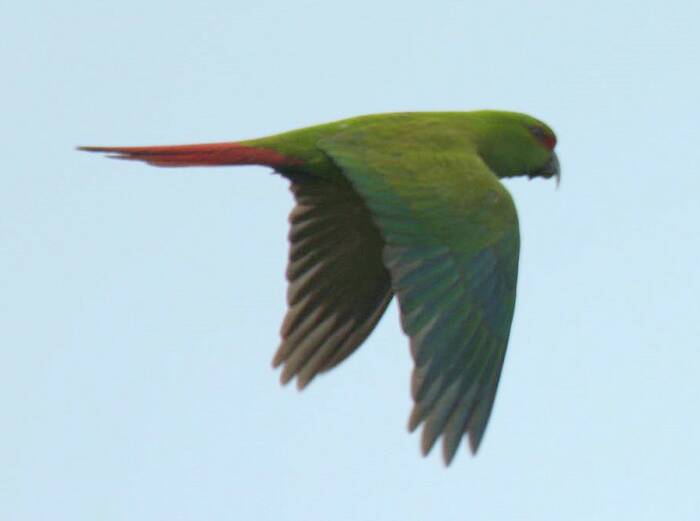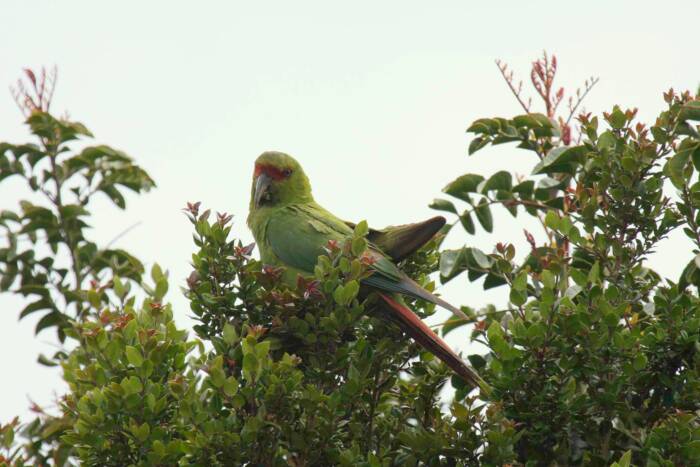Amigos de las Aves USA
The Parrot Fund
"Wild Parrots --
Keep Them Flying!"
Nesting Ecology of the Slender-Billed Conure in Southern Chile
Jaime E. Jiménez, PhD, Universidad de Los Lagos, Chile
Thomas H. White, Jr., Ph.D., U.S. Fish and Wildlife Service
The immediate funding needs for this project are for radio telemetry collars costing $205 each Donations for this purpose are needed by July 12 2008. If you can help, download this form here or donate on-line via our PayPal donation button:
This project has been completed
The Parrot Fund will match all donations dollar-for-dollar through July 12, 2008.
Unfortunately, although Slender-billed Conures are currently “protected” under Chilean law and considered Endangered (SAG 1998), the fundamental lack of basic ecological data on both the species and its relationship to remnant old-growth forest fragments precludes meaningful efforts by Chilean authorities to effectively protect either the species or its environment. Thus, the Slender-billed Conure is an endemic Psittacine for which we have no idea of how past and current human activities are affecting the species, or any idea of how to effectively protect and manage the species within the altered landscape in which it now occurs. It is extremely ironic that this situation exists considering the accessibility of the species for systematic study that could elucidate key aspects of its ecology vital to the development of effective strategies to insure its continued survival.
RESEARCH APPROACH AND OBJECTIVES
To acquire the data essential to understanding the species’ ecology, we propose to capture, radio-tag, and monitor the subsequent nesting activity of 25 adult Slender-billed Conures within the agricultural region near Osorno, Chile. To accomplish this, we will use spring-activated capture nets (similar to cannon nets) to capture the birds during the austral early spring (e.g., early October) at which time they form large ground-feeding flocks prior to the nesting season which begins during mid-November (Forshaw 1989, J. Jimenez, pers. observ.). By radio-tagging birds at this time, we will be able to subsequently track individual birds to their specific nest sites, document nest site and landscape variables, document foraging habitats and activities, and collect specific data on reproductive chronology and productivity. Further, because many Psittacines show marked interannual fidelity to successful nest sites (Wiley et al. 2004, Enkerlin-Hoeflich et al. 2006), we will also monitor the same nest sites the following nesting season (after transmitters have expired) to determine if these sites are also used again by the same or different nesting pairs, thereby potentially extending the acquisition of valuable nesting data well beyond that of the initial nesting season.
In addition to radio tracking and nest site analyses, we will also examine local knowledge of, and attitudes toward, Slender-billed Conures using modern human survey techniques. Because of the local problems apparently faced by the Conures due to crop depredation, habitat loss and nest poaching, it will be essential to assess the extent and levels of relevant sociological factors. This sociological data, combined with the ecological data acquired via the telemetry study, will be used to develop an integrated set of recommendations aimed at insuring species survival.
With most Psittacines, it is usually only when a species has become critically endangered that notice and actions are taken to avert extinction or further decline. Unfortunately, by such time the necessary conservation measures will have become extremely costly in terms of the human and financial resources needed to overcome daunting ecological and sociological challenges to recovery efforts. Notable examples include species such as the Puerto Rican Parrot (Amazona vittata) and Lear’s Macaw (Anodorhynchus leari), among several others (Derrickson and Snyder 1992, Snyder et al. 1999). It is our desire to take a more prudent and proactive approach with the Slender-billed Conure to insure that the species does not become a future “crisis case” requiring drastic and costly measures to insure its survival.
IMMEDIATE FUNDING NEEDS (This project has been completed)
Because radiotelemetry will be an essential component of this research, the timely acquisition of transmitters will be crucial to our efforts. Capture and instrumentation of the birds must occur during early-mid October 2008 in order to take advantage of the flocking and ground-feeding behavior exhibited at that time. Accordingly, the transmitter order must be placed with the manufacturer well in advance of this date to insure availability. Currently, the most appropriate transmitters for this species are the Holohil SB-2C units, which weigh approximately 6 grams (2.5% body weight of adult Conures) and cost U.S. $205.00 each. Thus, this represents an initial expenditure of U.S. $5,125.00 for 25 transmitters. The remaining necessary radio-tracking equipment (receivers, antennas, cables, headphones, etc.) is already on hand at Universidad de Los Lagos in Osorno, Chile, most of which was donated by the Puerto Rican Parrot Recovery Program of the U.S. Fish and Wildlife Service.

LITERATURE CITED
Collar, N. J. and A. T. Juniper. 1992. Dimensions and causes of the parrot conservation crisis. Pages 1-24 in S. R. Beissinger and N. F. R. Snyder, editors. New world parrots in crisis: solutions from conservation biology. Smithsonian Institution Press, Washington, D.C.
Derrickson, S. R. and N. F. R. Snyder. 1992. Potentials and limits of captive breeding in parrot conservation. Pages 133-163 in S. R. Beissinger and N. F. R. Snyder, editors. New world parrots in crisis: solutions from conservation biology. Smithsonian Institution Press, Washington, D.C.
Enkerlin-Hoeflich, E. C., N. F. R. Snyder, and J. W. Wiley. 2006. Behavior of wild Amazona and Rhynchopsitta parrots, with comparative insights from  other Psittacines. Pages 13-25 in A. U. Luescher, editor. Manual of parrot behavior. Blackwell Publishing, Oxford, U.K.
other Psittacines. Pages 13-25 in A. U. Luescher, editor. Manual of parrot behavior. Blackwell Publishing, Oxford, U.K.
Forshaw, J. M. 1989. Parrots of the world. Landsdowne Editions, Melbourne, Australia.
Jaramillo, A. 2003. Birds of Chile. Princeton University Press, Princeton, New Jersey, U.S.A.
Servicio Agrícola y Ganadero. 1998. Reglamento de la Ley de Caza, Decreto Supremos No. 5,
Servicio Agrícola y Ganadero, República de Chile.
Snyder, N. F. R., P. McGowan, J. Gilardi, and A. Grajal. 1999. Parrots: status survey and action plan. International Union for the Conservation of Nature, Cambridge, U.K.
Wiley, J. W., R. S. Gnam, S. E. Koenig, A. Dornelly, X. Galvez, P. E. Bradley, T. White, M. Zamore, P. R. Reillo, and D. Anthony. 2004. Status and conservation of the family Psittacidae in the West Indies. J. Carib. Ornithol.(Special Issue):94-154.
Ornithol.(Special Issue):94-154.


INTRODUCTION
The Slender-billed Conure (also known as Slender-billed Parakeet; Enicognathus leptorhynchus) is a medium-sized Psittacine endemic to the southern regions of Chile (Jaramillo 2003-- see map to right), and one of the most southerly occurring of all parrot species (Forshaw 1989). Detailed scientific data on the basic biology and ecology of the species are virtually nonexistent (see Forshaw 1989), despite the fact that the species occurs within areas easily accessible to researchers and is well known to local residents throughout its range. Although Slender-billed Conures are generally believed to require intact mountanous old-growth Nothofagus forests for nesting (Forshaw 1989), recent anecdotal information and direct observations indicate that the birds also make substantial use of scattered, remnant fragments of old-growth Nothofagus forests currently found within the extensive lowland agricultural landscapes of southern Chile. These remnant forest fragments are the product of decades of land use practices that have reduced native forest cover in southern Chile.
However, the use of these agricultural landscapes for both nesting and foraging by Slender-billed Conures has also led to increasingly frequent conflicts with human residents, particularly grain farmers, who often shoot Slender-billed Conures when found foraging on newly planted or germinating seeds. Moreover, as with many Psittacines, a lucrative and illegal market exists for wild-caught chicks to supply the pet trade, as evidenced by a recent (2002) confiscation of 400 Slender-billed Conures in Osorno which were allegedly destined for transport to markets in Santiago (Juan Lara, SAG Servicio Agrícola y Ganadero, Osorno, Chile, pers. comm.). In fact, in rural areas of southern Chile it is not uncommon to observe rudimentary “ladders” made of boards nailed to large Nothofagus trees which are used by poachers to access nest cavities. The current isolated and dispersed distribution of these old-growth Nothofagus fragments likely exacerbates the nest-poaching problem by making nest trees easier to locate. Finally, many of the existing large Nothofagus trees suitable for nesting by Slender-billed Conures are also being cut to supply the growing local demand for firewood. Among Psittacines in general, nest poaching and habitat loss are considered the two most significant factors in population declines and losses (Collar and Juniper 1992.
The immediate funding needs for this project are for radio telemetry collars costing $205 each Donations for this purpose are needed by July 12, 2008. If you can help, download this form here, or donate on-line by clicking on our PayPal donation button. Amigos de las Aves USA will match all donations dollar-for-dollar through July 12, 2008.
Last modified 3/20/2008
